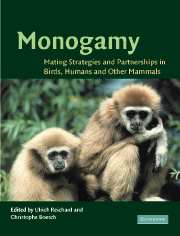Book contents
- Frontmatter
- Contents
- List of contributors
- Acknowledgements
- Introduction
- PART I Evolution of social monogamy
- PART II Reproductive strategies of socially monogamous males and females
- CHAPTER 6 Social functions of copulation in the socially monogamous razorbill (Alca torda)
- CHAPTER 7 Social and reproductive monogamy in rodents: the case of the Malagasy giant jumping rat (Hypogeomys antimena)
- CHAPTER 8 Social polyandry and promiscuous mating in a primate-like carnivore: the kinkajou (Potos flavus)
- CHAPTER 9 Monogamy correlates, socioecological factors, and mating systems in beavers
- CHAPTER 10 Social monogamy and social polygyny in a solitary ungulate, the Japanese serow (Capricornis crispus)
- PART III Reproductive strategies of human and non-human primates
- Index
CHAPTER 8 - Social polyandry and promiscuous mating in a primate-like carnivore: the kinkajou (Potos flavus)
Published online by Cambridge University Press: 05 July 2014
- Frontmatter
- Contents
- List of contributors
- Acknowledgements
- Introduction
- PART I Evolution of social monogamy
- PART II Reproductive strategies of socially monogamous males and females
- CHAPTER 6 Social functions of copulation in the socially monogamous razorbill (Alca torda)
- CHAPTER 7 Social and reproductive monogamy in rodents: the case of the Malagasy giant jumping rat (Hypogeomys antimena)
- CHAPTER 8 Social polyandry and promiscuous mating in a primate-like carnivore: the kinkajou (Potos flavus)
- CHAPTER 9 Monogamy correlates, socioecological factors, and mating systems in beavers
- CHAPTER 10 Social monogamy and social polygyny in a solitary ungulate, the Japanese serow (Capricornis crispus)
- PART III Reproductive strategies of human and non-human primates
- Index
Summary
INTRODUCTION
The class Mammalia includes a diverse array of societies, from solitary species that rarely meet except for mating, to species so gregarious that they are rarely out of contact with their many group mates. Within this continuum, social monogamy is more likely to evolve in the less gregarious lineages, but remains a rare strategy across the class (Kleiman, 1977; van Schaik & Kappeler, chapter 4).
However, the mammalian class is dominated by solitary social systems that are rarely studied in detail (Eisenberg, 1981). Some have suggested that the secretive nature of many mammals has made them difficult to study, and that ‘solitary mammal’ has become a default termused to classify many of these elusive species. Leyhausen (1965) recognized this: ‘the main reasonwhy so many mammals are said to be solitary seems to be that they can only be shot one at a time’. Indeed, modern techniques such as radio telemetry, night vision, and molecular analyses have revealed surprising complexity and sociality among many species previously classified as solitary.
Among the Carnivora, telemetry work has found male associations in slender mongooses (Galerella sanguinea: Rood, 1989) and northern raccoons (Procyon lotor: Gehrt & Fritzell, 1998). An ambitious cadre of night-loving primatologists has revealed an amazing diversity of sociality among nocturnal primates (Kappeler, 1997; Bearder, 1999; Sterling et al., 2000).
- Type
- Chapter
- Information
- MonogamyMating Strategies and Partnerships in Birds, Humans and Other Mammals, pp. 125 - 137Publisher: Cambridge University PressPrint publication year: 2003
- 3
- Cited by



